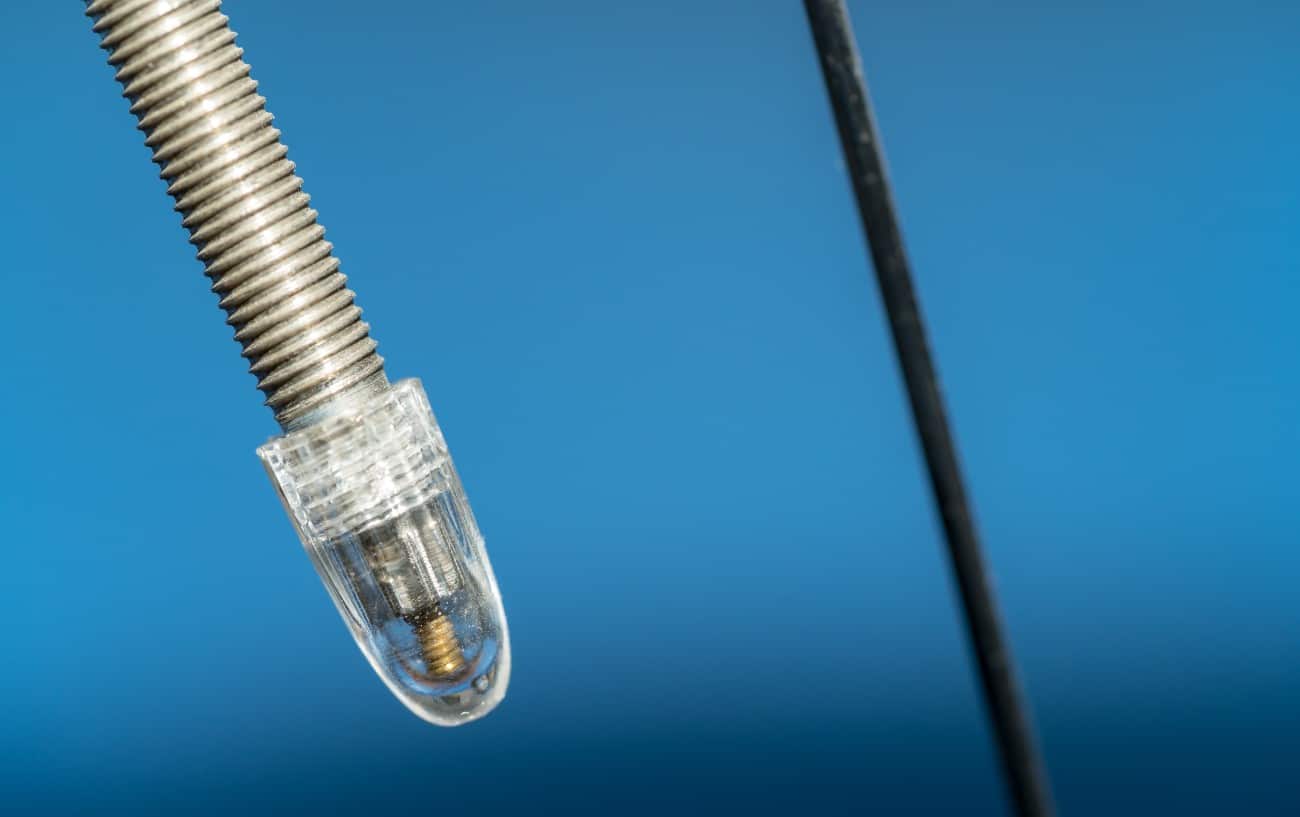When it comes to changing an inner tube, you’ll notice that there are a few different bike tire valve types.
If you carry a spare inner tube ready for when you get a puncture, it needs to have the correct bicycle tire valve, or it may not fit your wheel.
There’s nothing more frustrating than being stuck in the middle of nowhere because you can’t fix your flat tire. So, it’s best to have a grasp of the different bicycle tire valve types to keep you riding.
You can identify the different valves simply by how they look, as they’re all unique and work differently.
In this article, we’ll be covering:
- The Schrader Valve
- The Presta Valve
- The Dunlop Valve
- Tubeless Bike Tire Valves
- Bicycle Tire Valve Caps
Are you ready to become a bike tire valve types expert?
Let’s get started!

The Schrader Valve
The Schrader valve is a common type of bicycle valve, and has been used since the late 1800s.
Some cyclists refer to Schrader valves as “American Valves”, due to their U.S. patent in 1893.
You can identify a Schrader valve by its wide stem, which houses a small valve core.
The valve core keeps the valve closed using a small spring. When you depress the spring, the valve opens, allowing air to pass through the valve.

Pros Of The Schrader Valve
The shorter and wider design of a Schrader valve makes it more robust than other bike tire valve types. You can usually replace the valve core, too, so you don’t have to buy a new inner tube if the valve fails.
It is easy to find a pump compatible with Schrader valves, and they can hold high pressure in the tire – although some air is lost when you remove the pump.
Cons Of A Schrader Valve
The size of a Schrader valve means that your wheels need larger holes drilled into them, which can compromise the rim’s strength.
It also means that a tube with a Presta valve isn’t compatible unless you drill a larger hole. So, it’s essential to have the correct inner tube for the wheel.
Many Schrader valves will also not be long enough if you have deep wheels, requiring you to fit a valve extender.
How To use A Schrader Valve
There are five easy steps when using a Schrader bicycle tire valve to inflate or deflate a tire:
- Remove the valve cap, and clean off any dirt or debris.
- To deflate the tire, depress the pin in the center of the valve core. You can use a pen, screwdriver, or something else that is pointy. Even if you don’t want to deflate the tire, it is good to press the pin down anyway to get a quick blast of air to remove any remaining dirt.
- Now it’s time to pump up your tire. You may have a pump that twists onto the valve or just pushes onto it.
- Pump up your tire to your preferred pressure.
- Remove the pump from the valve and put the bicycle tire valve cap back on.
The Presta Valve

Presta valves are longer and narrower than Schrader valves and are found on most modern bikes (especially road bikes).
This type of valve is also known as the “French Valve”, as it was invented by Frenchman Etienne Sclaverand.
Presta valves are made in different lengths to suit wheels with different depths. They’re lightweight, so are used on most road bikes, and are increasingly popular for mountain bike wheels too.
The Presta valve stem holds the core with an internal thread. You’ll notice an external thread too, but this is for the rim nut. The rim nut stops the valve from falling into the wheel while inflating the tube.
Pros and Cons Of The Presta Valve
The small diameter of Presta valves means that the wheel only needs a small hole, which makes it stronger. This makes them a better choice for mountain bikes, while their minimal weight makes them ideal for road bikes.
It’s also possible to remove and replace the core of a Presta valve.
The design of Presta valves makes it easier to adjust tire pressure and prevents the buildup of dirt. You can also use them on wheels drilled for Schrader and Dunlop valves.
However, you need to be careful when pumping your tire up with a Presta valve, as they are pretty delicate. You can easily snap the thin stem if you’re too heavy-handed.
How To use A Presta Valve
There is nothing complicated about using a Presta valve, but there are a couple more steps to take than with a Schrader valve:
- Unscrew the bicycle tire valve cap and clean off any dirt or dust.
- Unscrew the small nut on the top of the Presta valve core until loose.
- Hold the pin down with your finger to deflate the tire, or briefly press it to get a small blast of air to clear any remaining dust.
- Carefully put your Presta valve compatible pump on top of the pin, and clamp it before pumping your tire to the required pressure.
- Remove the pump from the valve. Don’t worry about the sharp hiss of air; this is normal.
- Tighten the nut back down, so it’s flush with the top of the valve. This will stop the valve pin from being depressed.
- Replace the valve cap and get riding!
The Dunlop Valve

The Dunlop valve is also called the “Woods valve” or “English valve”.
The Dunlop valve isn’t used much in the U.S. or UK anymore, but you’ll still find them on bikes in some European and Asian countries.
This valve was invented by C.H. Woods and replaced the original Dunlop valve soon after it was developed. This version of the Dunlop valve was much easier to use and maintain than its predecessor.
The original used a rubber sleeve to control airflow, but this deteriorated, compromising its function. However, they’re still popular in developing countries as they are robust and easy to maintain.
Dunlop valves are a similar size to Schrader valves, but you need a Presta pump or a bike tire valve adapter to inflate the tire.
Pros And Cons Of A Dunlop Valve
The Dunlop valve’s ease of maintenance is enhanced by not needing any tools to fix or replace the valve core. They are cheap to buy, robust, and compatible with a Presta pump, so using them is pretty straightforward.
The main disadvantage of Dunlop valves is that they are hard to find in the U.S. or UK, as are the cores and bicycle tire valve caps.
How To Use a Dunlop Valve
Inflating an inner tube with a Dunlop valve is straightforward; all you need is a Presta compatible pump:
- Remove the valve cap and fit your pump to the top of the valve.
- Pump the tire up to the required pressure.
- Remove the pump and re-fit the valve cap.
Deflating a tire with a Dunlop valve differs from those with Schrader and Presta valves. This is because they don’t have a valve core pin that can be depressed:
- To deflate the tire, unscrew the valve stem cap from the Dunlop valve.
- Remove the nut from the top of the valve stem.
- Firmly grip the valve core and slowly pull it out of the valve stem (take care for this part!). Air will start to escape from the valve core. It can come out pretty quickly, so make sure you have a tight grip.
- Once all the air has come out of the tire, put the core back in its original position and put the top nut and valve cap back on.
Tubeless Bike Tire Valves

There are many advantages of tubeless tires, but there are some differences when it comes to the valves due to how the tubeless wheel setup works.
You can get tubeless Schrader and Presta valves, which work on their own without the need to fit an inner tube into the tire. The tubeless valve uses a rubber base that seals the hole in the wheel to maintain air pressure. This system is usually used in conjunction with a synthetic sealant inside the tire.
Pros and Cons Of Tubeless Bike Tire Valves
When you ride over something sharp enough to puncture your tire, the sealant fills the hole and solidifies. Therefore, minimal air escapes, and you don’t know that you have had a puncture most of the time.
If you get a hole in your tire too large for the sealant to fill, you can fit an inner tube to get you home.
Riding tubeless also allows you to ride with lower tire pressures. This increases the contact patch with the ground, creating more traction.
The main disadvantage of tubeless tires is that they can have a messy setup process. Also, you may find it challenging to get a good seal if you have cheap wheels.
Bicycle Tire Valve Caps
Bicycle tire valve caps don’t play any part in keeping the air in your tires, but they protect your valves from dirt, debris, and impacts that can damage them.
Caps are inexpensive and accessible, so there is no reason why you should be riding without them. But if you lose one, you need to make sure you buy a replacement compatible with your valve.
You can even customize your bike with cool-looking bicycle tire valve caps that match your bike’s color scheme. However, you usually get a new one with a replacement inner tube, so it’s worth keeping them as spares.

Now You Know All About Bike Tire Valve Types…
Bicycle tire valves are not complicated, but it is worth knowing their differences. The key things to remember are that your valves need to fit through the holes in the wheels, and you have a compatible pump.
Now you know all about the different bike tire valve types, get out on your bike and put the new knowledge to use!




Why so many valves for bike tires, just cost me a 20 mile trip for another tube. These things should be sold with adapters included.
Specifically: Blackburn inner tube 27.5 bought at Walmart. Stupid!!!
Great explanation Tom.
One advantage I might add for the Shrader valve is it’s easier (and cleaner) to add a product like Flat-Out to tubes with this valve. I’ve used the Flat-Out product for our fat tired and leisure tired pedal-assist e-bikes.
And I changed to Shrader valves for our smaller format (2.25″) tires for leisure HPV riding as well for the same reason. As we have gotten older fixing a flat on the road (especially for e-bikes) becomes a huge task, thus the Flat-Out product.
Actually the HPV leisure bikes I initially changed as we were getting flats from goat heads (aka bull thorns) on the trails and roads about every third or fourth time we went riding.
We were also having real trouble with the Presta valves getting cut by the rims. Even the bike shops were unable to get the holes smooth enough. I finally found grommets that stopped that problem, but the weed thorns were just too much to deal with.